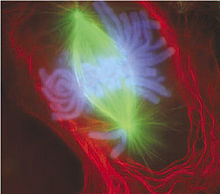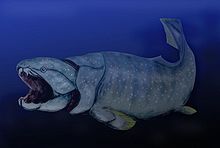- Animal
-
"Animalia" redirects here. For other uses, see Animalia (disambiguation).For other uses, see Animal (disambiguation).
Animals
Temporal range: Ediacaran - Recent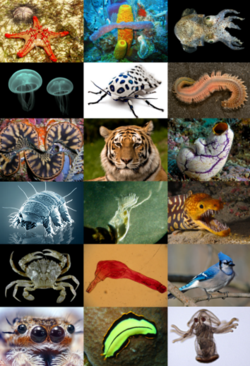
Scientific classification Domain: Eukaryota (unranked) Opisthokonta (unranked) Holozoa (unranked) Filozoa Kingdom: Animalia
Linnaeus, 1758Phyla - Subkingdom Parazoa
- Porifera
- Placozoa
- Subkingdom Eumetazoa
- Radiata (unranked)
- Bilateria (unranked)
- Orthonectida
- Rhombozoa
- Acoelomorpha
- Chaetognatha
- Superphylum Deuterostomia
- Chordata
- Hemichordata
- Echinodermata
- Xenoturbellida
- Vetulicolia †
- Protostomia (unranked)
- Superphylum Ecdysozoa
- Kinorhyncha
- Loricifera
- Priapulida
- Nematoda
- Nematomorpha
- Lobopodia
- Onychophora
- Tardigrada
- Arthropoda
- Superphylum Platyzoa
- Platyhelminthes
- Gastrotricha
- Rotifera
- Acanthocephala
- Gnathostomulida
- Micrognathozoa
- Cycliophora
- Superphylum Lophotrochozoa
- Superphylum Ecdysozoa
Animals are a major group of multicellular, eukaryotic organisms of the kingdom Animalia or Metazoa. Their body plan eventually becomes fixed as they develop, although some undergo a process of metamorphosis later on in their life. Most animals are motile, meaning they can move spontaneously and independently. All animals are also heterotrophs, meaning they must ingest other organisms or their products for sustenance.
Most known animal phyla appeared in the fossil record as marine species during the Cambrian explosion, about 542 million years ago.
Contents
Etymology
The word "animal" comes from the Latin word animalis, meaning "having breath".[1] In everyday colloquial usage, the word usually refers to non-human animals.[2] Sometimes, only closer relatives of humans such as mammals and other vertebrates are meant in colloquial use.[3] The biological definition of the word refers to all members of the kingdom Animalia, encompassing creatures as diverse as sponges, jellyfish, insects and humans.[4]
Characteristics
Animals have several characteristics that set them apart from other living things. Animals are eukaryotic and mostly multicellular,[5] which separates them from bacteria and most protists. They are heterotrophic,[6] generally digesting food in an internal chamber, which separates them from plants and algae.[7] They are also distinguished from plants, algae, and fungi by lacking rigid cell walls.[8] All animals are motile,[9] if only at certain life stages. In most animals, embryos pass through a blastula stage,[10] which is a characteristic exclusive to animals.
Structure
With a few exceptions, most notably the sponges (Phylum Porifera) and Placozoa, animals have bodies differentiated into separate tissues. These include muscles, which are able to contract and control locomotion, and nerve tissues, which send and process signals. Typically, there is also an internal digestive chamber, with one or two openings.[11] Animals with this sort of organization are called metazoans, or eumetazoans when the former is used for animals in general.[12]
All animals have eukaryotic cells, surrounded by a characteristic extracellular matrix composed of collagen and elastic glycoproteins.[13] This may be calcified to form structures like shells, bones, and spicules.[14] During development, it forms a relatively flexible framework[15] upon which cells can move about and be reorganized, making complex structures possible. In contrast, other multicellular organisms, like plants and fungi, have cells held in place by cell walls, and so develop by progressive growth.[11] Also, unique to animal cells are the following intercellular junctions: tight junctions, gap junctions, and desmosomes.[16]
Reproduction and development
Nearly all animals undergo some form of sexual reproduction.[17] They have a few specialized reproductive cells, which undergo meiosis to produce smaller, motile spermatozoa or larger, non-motile ova.[18] These fuse to form zygotes, which develop into new individuals.[19]
Many animals are also capable of asexual reproduction.[20] This may take place through parthenogenesis, where fertile eggs are produced without mating, budding, or fragmentation.[21]
A zygote initially develops into a hollow sphere, called a blastula,[22] which undergoes rearrangement and differentiation. In sponges, blastula larvae swim to a new location and develop into a new sponge.[23] In most other groups, the blastula undergoes more complicated rearrangement.[24] It first invaginates to form a gastrula with a digestive chamber, and two separate germ layers — an external ectoderm and an internal endoderm.[25] In most cases, a mesoderm also develops between them.[26] These germ layers then differentiate to form tissues and organs.[27]
Food and energy sourcing
Main article: Animal nutritionAll animals are heterotrophs, meaning that they feed directly or indirectly on other living things.[28] They are often further subdivided into groups such as carnivores, herbivores, omnivores, and parasites.[29]
Predation is a biological interaction where a predator (a heterotroph that is hunting) feeds on its prey (the organism that is attacked).[30] Predators may or may not kill their prey prior to feeding on them, but the act of predation always results in the death of the prey.[31] The other main category of consumption is detritivory, the consumption of dead organic matter.[32] It can at times be difficult to separate the two feeding behaviours, for example, where parasitic species prey on a host organism and then lay their eggs on it for their offspring to feed on its decaying corpse. Selective pressures imposed on one another has led to an evolutionary arms race between prey and predator, resulting in various antipredator adaptations.[33]
Most animals feed indirectly from the energy of sunlight. Plants use this energy to convert sunlight into simple sugars using a process known as photosynthesis. Starting with the molecules carbon dioxide (CO2) and water (H2O), photosynthesis converts the energy of sunlight into chemical energy stored in the bonds of glucose (C6H12O6) and releases oxygen (O2). These sugars are then used as the building blocks which allow the plant to grow.[11] When animals eat these plants (or eat other animals which have eaten plants), the sugars produced by the plant are used by the animal.[34] They are either used directly to help the animal grow, or broken down, releasing stored solar energy, and giving the animal the energy required for motion.[35] This process is known as glycolysis.[36]
Animals living close to hydrothermal vents and cold seeps on the ocean floor are not dependent on the energy of sunlight.[37] Instead chemosynthetic archaea and bacteria form the base of the food chain.[38]
Origin and fossil record
Further information: Urmetazoan Vernanimalcula guizhouena is a fossil believed by some to represent the earliest known member of the Bilateria.
Vernanimalcula guizhouena is a fossil believed by some to represent the earliest known member of the Bilateria.
Animals are generally considered to have evolved from a flagellated eukaryote.[40] Their closest known living relatives are the choanoflagellates, collared flagellates that have a morphology similar to the choanocytes of certain sponges.[41] Molecular studies place animals in a supergroup called the opisthokonts, which also include the choanoflagellates, fungi and a few small parasitic protists.[42] The name comes from the posterior location of the flagellum in motile cells, such as most animal spermatozoa, whereas other eukaryotes tend to have anterior flagella.[43]
The first fossils that might represent animals appear in the Trezona Formation at Trezona Bore, West Central Flinders, South Australia.[44] These fossils are interpreted as being early sponges. They were found in 665-million-year-old rock.[44]
The next oldest possible animal fossils are found towards the end of the Precambrian, around 610 million years ago, and are known as the Ediacaran or Vendian biota.[45] These are difficult to relate to later fossils, however. Some may represent precursors of modern phyla, but they may be separate groups, and it is possible they are not really animals at all.[46]
Aside from them, most known animal phyla make a more or less simultaneous appearance during the Cambrian period, about 542 million years ago.[47] It is still disputed whether this event, called the Cambrian explosion, represents a rapid divergence between different groups or a change in conditions that made fossilization possible.
Some paleontologists suggest that animals appeared much earlier than the Cambrian explosion, possibly as early as 1 billion years ago.[48] Trace fossils such as tracks and burrows found in the Tonian era indicate the presence of triploblastic worms, like metazoans, roughly as large (about 5 mm wide) and complex as earthworms.[49] During the beginning of the Tonian period around 1 billion years ago, there was a decrease in Stromatolite diversity, which may indicate the appearance of grazing animals, since stromatolite diversity increased when grazing animals went extinct at the End Permian and End Ordovician extinction events, and decreased shortly after the grazer populations recovered. However the discovery that tracks very similar to these early trace fossils are produced today by the giant single-celled protist Gromia sphaerica casts doubt on their interpretation as evidence of early animal evolution.[50][51]
Groups of animals
Porifera, Radiata and basal Bilateria
Phylogenetic analysis suggests that the Porifera and Ctenophora diverged before a clade that gave rise to the Bilateria, Cnidaria and Placozoa.[52]
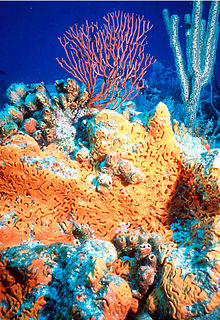 Orange elephant ear sponge, Agelas clathrodes, in foreground. Two corals in the background: a sea fan, Iciligorgia schrammi, and a sea rod, Plexaurella nutans.
Orange elephant ear sponge, Agelas clathrodes, in foreground. Two corals in the background: a sea fan, Iciligorgia schrammi, and a sea rod, Plexaurella nutans.
The sponges (Porifera) were long thought to have diverged from other animals early.[53] They lack the complex organization found in most other phyla.[54] Their cells are differentiated, but in most cases not organized into distinct tissues.[55] Sponges typically feed by drawing in water through pores.[56] Archaeocyatha, which have fused skeletons, may represent sponges or a separate phylum.[57] However, a phylogenomic study in 2008 of 150 genes in 29 animals across 21 phyla revealed that it is the Ctenophora or comb jellies which are the basal lineage of animals, at least among those 21 phyla. The authors speculate that sponges—or at least those lines of sponges they investigated—are not so primitive, but may instead be secondarily simplified.[58]
Among the other phyla, the Ctenophora and the Cnidaria, which includes sea anemones, corals, and jellyfish, are radially symmetric and have digestive chambers with a single opening, which serves as both the mouth and the anus.[59] Both have distinct tissues, but they are not organized into organs.[60] There are only two main germ layers, the ectoderm and endoderm, with only scattered cells between them. As such, these animals are sometimes called diploblastic.[61] The tiny placozoans are similar, but they do not have a permanent digestive chamber.
The remaining animals form a monophyletic group called the Bilateria. For the most part, they are bilaterally symmetric, and often have a specialized head with feeding and sensory organs. The body is triploblastic, i.e. all three germ layers are well-developed, and tissues form distinct organs. The digestive chamber has two openings, a mouth and an anus, and there is also an internal body cavity called a coelom or pseudocoelom. There are exceptions to each of these characteristics, however — for instance adult echinoderms are radially symmetric, and certain parasitic worms have extremely simplified body structures.
Genetic studies have considerably changed our understanding of the relationships within the Bilateria. Most appear to belong to two major lineages: the deuterostomes and the protostomes, the latter of which includes the Ecdysozoa, Platyzoa, and Lophotrochozoa. In addition, there are a few small groups of bilaterians with relatively similar structure that appear to have diverged before these major groups. These include the Acoelomorpha, Rhombozoa, and Orthonectida. The Myxozoa, single-celled parasites that were originally considered Protozoa, are now believed to have developed from the Medusozoa as well.
Deuterostomes
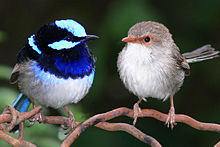 Superb Fairy-wren, Malurus cyaneus
Superb Fairy-wren, Malurus cyaneus
Deuterostomes differ from the other Bilateria, called protostomes, in several ways. In both cases there is a complete digestive tract. However, in protostomes, the first opening of the gut to appear in embryological development (the archenteron) develops into the mouth, with the anus forming secondarily. In deuterostomes the anus forms first, with the mouth developing secondarily.[62] In most protostomes, cells simply fill in the interior of the gastrula to form the mesoderm, called schizocoelous development, but in deuterostomes, it forms through invagination of the endoderm, called enterocoelic pouching.[63] Deuterostomes also have a dorsal, rather than a ventral, nerve chord and their embryos undergo different cleavage.
All this suggests the deuterostomes and protostomes are separate, monophyletic lineages. The main phyla of deuterostomes are the Echinodermata and Chordata.[64] The former are radially symmetric and exclusively marine, such as starfish, sea urchins, and sea cucumbers.[65] The latter are dominated by the vertebrates, animals with backbones.[66] These include fish, amphibians, reptiles, birds, and mammals.[67]
In addition to these, the deuterostomes also include the Hemichordata, or acorn worms.[68] Although they are not especially prominent today, the important fossil graptolites may belong to this group.[69]
The Chaetognatha or arrow worms may also be deuterostomes, but more recent studies suggest protostome affinities.
Ecdysozoa
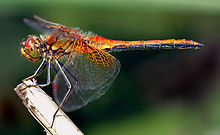 Yellow-winged darter, Sympetrum flaveolum
Yellow-winged darter, Sympetrum flaveolum
The Ecdysozoa are protostomes, named after the common trait of growth by moulting or ecdysis.[70] The largest animal phylum belongs here, the Arthropoda, including insects, spiders, crabs, and their kin. All these organisms have a body divided into repeating segments, typically with paired appendages. Two smaller phyla, the Onychophora and Tardigrada, are close relatives of the arthropods and share these traits.
The ecdysozoans also include the Nematoda or roundworms, perhaps the second largest animal phylum. Roundworms are typically microscopic, and occur in nearly every environment where there is water.[71] A number are important parasites.[72] Smaller phyla related to them are the Nematomorpha or horsehair worms, and the Kinorhyncha, Priapulida, and Loricifera. These groups have a reduced coelom, called a pseudocoelom.
The remaining two groups of protostomes are sometimes grouped together as the Spiralia, since in both embryos develop with spiral cleavage.
Platyzoa
The Platyzoa include the phylum Platyhelminthes, the flatworms.[73] These were originally considered some of the most primitive Bilateria, but it now appears they developed from more complex ancestors.[74] A number of parasites are included in this group, such as the flukes and tapeworms.[73] Flatworms are acoelomates, lacking a body cavity, as are their closest relatives, the microscopic Gastrotricha.[75]
The other platyzoan phyla are mostly microscopic and pseudocoelomate. The most prominent are the Rotifera or rotifers, which are common in aqueous environments. They also include the Acanthocephala or spiny-headed worms, the Gnathostomulida, Micrognathozoa, and possibly the Cycliophora.[76] These groups share the presence of complex jaws, from which they are called the Gnathifera.
Lophotrochozoa
The Lophotrochozoa include two of the most successful animal phyla, the Mollusca and Annelida.[77][78] The former, which is the second-largest animal phylum by number of described species, includes animals such as snails, clams, and squids, and the latter comprises the segmented worms, such as earthworms and leeches. These two groups have long been considered close relatives because of the common presence of trochophore larvae, but the annelids were considered closer to the arthropods because they are both segmented.[79] Now, this is generally considered convergent evolution, owing to many morphological and genetic differences between the two phyla.[80]
The Lophotrochozoa also include the Nemertea or ribbon worms, the Sipuncula, and several phyla that have a ring of ciliated tentacles around the mouth, called a lophophore.[81] These were traditionally grouped together as the lophophorates.[82] but it now appears that the lophophorate group may be paraphyletic,[83] with some closer to the nemerteans and some to the molluscs and annelids.[84][85] They include the Brachiopoda or lamp shells, which are prominent in the fossil record, the Entoprocta, the Phoronida, and possibly the Bryozoa or moss animals.[86]
Model organisms
Main articles: Model organism and Animal testingBecause of the great diversity found in animals, it is more economical for scientists to study a small number of chosen species so that connections can be drawn from their work and conclusions extrapolated about how animals function in general. Because they are easy to keep and breed, the fruit fly Drosophila melanogaster and the nematode Caenorhabditis elegans have long been the most intensively studied metazoan model organisms, and were among the first life-forms to be genetically sequenced. This was facilitated by the severely reduced state of their genomes, but as many genes, introns, and linkages lost, these ecdysozoans can teach us little about the origins of animals in general. The extent of this type of evolution within the superphylum will be revealed by the crustacean, annelid, and molluscan genome projects currently in progress. Analysis of the starlet sea anemone genome has emphasised the importance of sponges, placozoans, and choanoflagellates, also being sequenced, in explaining the arrival of 1500 ancestral genes unique to the Eumetazoa.[87]
An analysis of the homoscleromorph sponge Oscarella carmela also suggests that the last common ancestor of sponges and the eumetazoan animals was more complex than previously assumed.[88]
Other model organisms belonging to the animal kingdom include the mouse (Mus musculus) and zebrafish (Danio rerio).
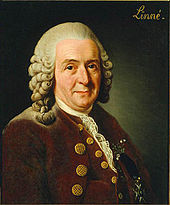 Carolus Linnaeus, known as the father of modern taxonomy
Carolus Linnaeus, known as the father of modern taxonomy
History of classification
Aristotle divided the living world between animals and plants, and this was followed by Carolus Linnaeus (Carl von Linné), in the first hierarchical classification.[89] Since then biologists have begun emphasizing evolutionary relationships, and so these groups have been restricted somewhat. For instance, microscopic protozoa were originally considered animals because they move, but are now treated separately.
In Linnaeus's original scheme, the animals were one of three kingdoms, divided into the classes of Vermes, Insecta, Pisces, Amphibia, Aves, and Mammalia. Since then the last four have all been subsumed into a single phylum, the Chordata, whereas the various other forms have been separated out. The above lists represent our current understanding of the group, though there is some variation from source to source.
See also
- Ethology
- Animal colouration
- Animal rights
- Fauna
- List of animal names
- List of animals by number of neurons
- Lists of animals
References
- ^ Cresswell, Julia (2010). The Oxford Dictionary of Word Origins (2 ed.). New York: Oxford University Press. ISBN 9780199547937. "‘having the breath of life’, from anima ‘air, breath, life’ ."
- ^ Webster's. "Animal Definition". http://www.yourdictionary.com/animal. Retrieved September 17, 2009.
- ^ "Animals". Merriam-Webster's. http://m-w.com/dictionary/animals. Retrieved 16 May 2010. "2 a : one of the lower animals as distinguished from human beings b : mammal; broadly : vertebrate"
- ^ "Animal". The American Heritage Dictionary (Forth ed.). Houghton Mifflin Company. 2006.
- ^ National Zoo. "Panda Classroom". http://nationalzoo.si.edu/Animals/GiantPandas/PandasForKids/classification/classification.htm. Retrieved September 30, 2007.
- ^ Jennifer Bergman. "Heterotrophs". http://www.windows.ucar.edu/tour/link=/earth/Life/heterotrophs.html&edu=high. Retrieved September 30, 2007.
- ^ Douglas AE, Raven JA, AE (January 2003). "Genomes at the interface between bacteria and organelles". Philosophical transactions of the Royal Society of London. Series B, Biological sciences 358 (1429): 5–17; discussion 517–8. doi:10.1098/rstb.2002.1188. ISSN 0962-8436. PMC 1693093. PMID 12594915. http://www.pubmedcentral.nih.gov/articlerender.fcgi?tool=pmcentrez&artid=1693093.
- ^ Davidson, Michael W.. "Animal Cell Structure". http://micro.magnet.fsu.edu/cells/animalcell.html. Retrieved September 20, 2007.
- ^ Saupe, S.G. "Concepts of Biology". http://employees.csbsju.edu/SSAUPE/biol116/Zoology/digestion.htm. Retrieved September 30, 2007.
- ^ Minkoff, Eli C. (2008). Barron's EZ-101 Study Keys Series: Biology (2, revised ed.). Barron's Educational Series. p. 48. ISBN 9780764139208.
- ^ a b c Adam-Carr, Christine; Hayhoe, Christy; Hayhoe, Douglas; Hayhoe, Katharine (2010). Science Perspectives 10. Nelson Education Ltd.. ISBN 978-0-17-635528-9.
- ^ Gero HIllmer; Ulrich Lehmann (1983). Fossil Invertebrates. CUP Archive. p. 54. ISBN 9780521270281.
- ^ Alberts, Bruce; Alexander Johnson, Julian Lewis, Martin Raff, Keith Roberts, and Peter Walter (2002). Molecular Biology of the Cell (4 ed.). New York: Garland Science. http://www.ncbi.nlm.nih.gov/books/NBK26810/.
- ^ Sangwal, Keshra (2007). Additives and crystallization processes: from fundamentals to applications. John Wiley and Sons. p. 212. ISBN 9780470061534.
- ^ Becker, Wayne M. (1991). The world of the cell. Benjamin/Cummings. ISBN 9780805308709.
- ^ Magloire, Kim (2004). Cracking the AP Biology Exam, 2004-2005 Edition. The Princeton Review. p. 45. ISBN 9780375763939.
- ^ Knobil, Ernst (1998). Encyclopedia of reproduction, Volume 1. Academic Press. p. 315. ISBN 9780122270208.
- ^ Schwartz, Jill (2010). Master the GED 2011 (w/CD). Peterson's. p. 371. ISBN 9780768928853.
- ^ Hamilton, Matthew B. (2009). Population genetics. Wiley-Blackwell. p. 55. ISBN 9781405132770.
- ^ Adiyodi, K. G.; Roger N. Hughes, Rita G. Adiyodi (2002). Reproductive Biology of Invertebrates, Progress in Asexual Reproduction, Volume 11. Wiley. p. 116.
- ^ Kaplan (2008). GRE exam subject test. Kaplan Publishing. p. 233. ISBN 9781419552182.
- ^ Tmh (2006). Study Package For Medical College Entrance Examinations. Tata McGraw-Hill. p. 6.22. ISBN 9780070616370.
- ^ Ville, Claude Alvin; Warren Franklin Walker, Robert D. Barnes (1984). General zoology. Saunders College Pub. p. 467. ISBN 9780030624513.
- ^ Hamilton, William James; James Dixon Boyd, Harland Winfield Mossman (1945). Human embryology: (prenatal development of form and function). Williams & Wilkins. p. 330.
- ^ Philips, Joy B. (1975). Development of vertebrate anatomy. Mosby. p. 176. ISBN 9780801639272.
- ^ The Encyclopedia Americana: a library of universal knowledge, Volume 10. Encyclopedia Americana Corp.. 1918. p. 281.
- ^ Romoser, William S.; J. G. Stoffolano (1998). The science of entomology. WCB McGraw-Hill. p. 156. ISBN 9780697228482.
- ^ Rastogi, V. B. (1997). Modern Biology. Pitambar Publishing. p. 3. ISBN 9788120904965.
- ^ Levy, Charles K. (1973). Elements of Biology. Appleton-Century-Crofts. p. 108. ISBN 9780390556271.
- ^ Begon, M., Townsend, C., Harper, J. (1996). Ecology: Individuals, populations and communities (Third edition). Blackwell Science, London. ISBN 0-86542-845-X, ISBN 0-632-03801-2, ISBN 0-632-04393-8.
- ^ Encyclopedia Britannica: "predation"
- ^ Marchetti, Mauro; Victoria Rivas (2001). Geomorphology and environmental impact assessment. Taylor & Francis. p. 84. ISBN 9789058093448.
- ^ Allen, Larry Glen; Daniel J. Pondella, Michael H. Horn (2006). Ecology of marine fishes: California and adjacent waters. University of California Press. p. 428. ISBN 9780520246539.
- ^ Clutterbuck, Peter (2000). Understanding Science: Upper Primary. Blake Education. p. 9. ISBN 9781865091709.
- ^ Gupta, P.K.. Genetics Classical To Modern. Rastogi Publications. p. 26. ISBN 9788171338962.
- ^ Garrett, Reginald; Grisham, Charles M. (2010). Biochemistry. Cengage Learning. p. 535. ISBN 9780495109358.
- ^ New scientist (IPC Magazines) 152 (2050–2055): 105. 1996.
- ^ Castro, Peter; Michael E. Huber (2007). Marine Biology (7 ed.). McGraw-Hill. p. 376. ISBN 9780077221249.
- ^ Monster fish crushed opposition with strongest bite ever, smh.com.au
- ^ Campbell, Niel A. (1990). Biology (2 ed.). Benjamin/Cummings Pub. Co.. p. 560. ISBN 9780805318005.
- ^ Richard R. Behringer, Alexander D. Johnson, Robert E. Krumlauf, Michael K. Levine, Nipam Patel, Neelima Sinha, ed (2008). Emerging model organisms: a laboratory manual, Volume 1 (illustrated ed.). Cold Spring Harbor Laboratory Press. p. 1. ISBN 9780879698720.
- ^ Hall, Brian Keith; Benedikt Hallgrímsson, Monroe W. Strickberger (2008). Strickberger's evolution: the integration of genes, organisms and populations. Jones & Bartlett Learning. p. 278. ISBN 9780763700669.
- ^ Hamilton, Gina. Kingdoms of Life - Animals (ENHANCED eBook). Lorenz Educational Press. p. 9. ISBN 9781429116107.
- ^ a b Maloof, Adam C.; Rose, Catherine V.; Beach, Robert; Samuels, Bradley M.; Calmet, Claire C.; Erwin, Douglas H.; Poirier, Gerald R.; Yao, Nan et al. (17 August 2010). "Possible animal-body fossils in pre-Marinoan limestones from South Australia". Nature Geoscience 3 (9): 653. Bibcode 2010NatGe...3..653M. doi:10.1038/ngeo934. http://www.nature.com/ngeo/journal/vaop/ncurrent/full/ngeo934.html.
- ^ Costa, James T.; Charles Darwin (2009). The annotated Origin: a facsimile of the first edition of On the origin of species. Harvard University Press. p. 308. ISBN 9780674032811.
- ^ Schopf, J. William (1999). Evolution!: facts and fallacies. Academic Press. p. 7. ISBN 9780126288605.
- ^ Milsom, Clare; Sue Rigby (2009). Fossils at a Glance. John Wiley and Sons. ISBN 9781405193368.
- ^ Campbell. Neil A.; Jane B. Reece (2005). Biology (7 ed.). Pearson, Benjamin Cummings. p. 526. ISBN 9780805371710.
- ^ Seilacher, A., Bose, P.K. and Pflüger, F., A (Oct 1998). "Animals More Than 1 Billion Years Ago: Trace Fossil Evidence from India". Science 282 (5386): 80–83. Bibcode 1998Sci...282...80S. doi:10.1126/science.282.5386.80. ISSN 0036-8075. PMID 9756480. http://www.sciencemag.org/cgi/content/abstract/282/5386/80. Retrieved 2007-08-20.
- ^ Matz, MV; Frank, TM; Marshall, NJ; Widder, EA; Johnsen, S; Tamara M. Frank, N. Justin Marshall, Edith A. Widder and Sonke Johnsen (2008-12-09). "Giant Deep-Sea Protist Produces Bilaterian-like Traces". Current Biology (Elsevier Ltd) 18 (23): 1–6. doi:10.1016/j.cub.2008.10.028. ISSN 0960-9822. PMID 19026540. http://www.biology.duke.edu/johnsenlab/pdfs/pubs/sea%20grapes%202008.pdf. Retrieved 2008-12-05.
- ^ Reilly, Michael (2008-11-20). "Single-celled giant upends early evolution". MSNBC. http://www.msnbc.msn.com/id/27827279/. Retrieved 2008-12-05.
- ^ Ryan JF, Pang K; NISC Comparative Sequencing Program, Mullikin JC, Martindale MQ, Baxevanis AD (2010) The homeodomain complement of the ctenophore Mnemiopsis leidyi suggests that Ctenophora and Porifera diverged prior to the ParaHoxozoa. Evodevo 1(1):9
- ^ Bhamrah, H. S.; Kavita Juneja (2003). An Introduction to Porifera. Anmol Publications PVT. LTD.. p. 58. ISBN 9788126106752.
- ^ Sumich, James L. (2008). Laboratory and Field Investigations in Marine Life. Jones & Bartlett Learning. p. 67. ISBN 9780763757304.
- ^ Jessop, Nancy Meyer (1970). Biosphere; a study of life. Prentice-Hall. p. 428.
- ^ Sharma, N. S. (2005). Continuity And Evolution Of Animals. Mittal Publications. p. 106. ISBN 9788182930186.
- ^ McGraw-Hill encyclopedia of science & technology: MET-NIC., Volume 11 (8 ed.). McGraw-Hill. 1997. p. 59. ISBN 9780079115041. http://books.google.com/?id=GS5YAAAAMAAJ&dq=Archaeocyatha%2C+which+have+fused+skeletons%2C+may+represent+sponges+or+a+separate+phylum&q=They+are+normally+treated+as+a+class+or+phylum+of+animals. Retrieved 19 March 2011.
- ^ Dunn et al. 2008. "Broad phylogenomic sampling improves resolution of the animal tree of life". Nature 06614.
- ^ Langstroth, Lovell; Libby Langstroth, Todd Newberry, Monterey Bay Aquarium (2000). A living bay: the underwater world of Monterey Bay. University of California Press. p. 244. ISBN 9780520221499.
- ^ Safra, Jacob E. (2003). The New Encyclopaedia Britannica, Volume 16. Encyclopaedia Britannica. p. 523. ISBN 9780852299616.
- ^ Kotpal, R. L.. Modern Text Book of Zoology: Invertebrates. Rastogi Publications. p. 184. ISBN 9788171339037.
- ^ Peters, Kenneth E.; Clifford C. Walters, J. Michael Moldowan (2005). The Biomarker Guide: Biomarkers and isotopes in petroleum systems and Earth history. Cambridge University Press. p. 717. ISBN 9780521837620.
- ^ Safra, Jacob E. (2003). The New Encyclopaedia Britannica, Volume 1; Volume 3. Encyclopaedia Britannica. p. 767. ISBN 9780852299616.
- ^ Hyde, Kenneth (2004). Zoology: An Inside View of Animals. Kendall Hunt. p. 345. ISBN 9780757509971.
- ^ Alcamo, Edward (1998). Biology Coloring Workbook. The Princeton Review. p. 220. ISBN 9780679778844.
- ^ Holmes, Thom (2008). The First Vertebrates. Infobase Publishing. p. 64. ISBN 9780816059584.
- ^ Rice, Stanley A. (2007). Encyclopedia of evolution. Infobase Publishing. p. 75. ISBN 9780816055159.
- ^ Tobin, Allan J.; Jennie Dusheck (2005). Asking about life. Cengage Learning. p. 497. ISBN 9780534406530.
- ^ Safra, Jacob E. (2003). The New Encyclopaedia Britannica, Volume 19. Encyclopaedia Britannica. p. 791. ISBN 9780852299616.
- ^ Dawkins, Richard (2005). The Ancestor's Tale: A Pilgrimage to the Dawn of Evolution. Houghton Mifflin Harcourt. p. 381. ISBN 9780618619160.
- ^ Prewitt, Nancy L.; Larry S. Underwood, William Surver (2003). BioInquiry: making connections in biology. John Wiley. p. 289. ISBN 9780471202288.
- ^ Schmid-Hempel, Paul (1998). Parasites in social insects. Princeton University Press. p. 75. ISBN 9780691059242.
- ^ a b Gilson, Étienne (2004). El espíritu de la filosofía medieval. Ediciones Rialp. p. 384. ISBN 9788432134920.
- ^ Ruiz-Trillo, I., I; Ruiz-Trillo, Iñaki; Riutort, Marta; Littlewood, D. Timothy J.; Herniou, Elisabeth A.; Baguñà, Jaume (March 1999). "Acoel Flatworms: Earliest Extant Bilaterian Metazoans, Not Members of Platyhelminthes". Science 283 (5409): 1919–1923. Bibcode 1999Sci...283.1919R. doi:10.1126/science.283.5409.1919. ISSN 0036-8075. PMID 10082465.
- ^ Todaro, Antonio. "Gastrotricha: Overview". Gastrotricha: World Portal. University of Modena & Reggio Emilia. http://www.gastrotricha.unimore.it/overview.htm. Retrieved 2008-01-26.
- ^ Kristensen, Reinhardt Møbjerg (July 2002). "An Introduction to Loricifera, Cycliophora, and Micrognathozoa". Integrative and Comparative Biology (Oxford Journals) 42 (3): 641–651. doi:10.1093/icb/42.3.641. http://icb.oxfordjournals.org/cgi/content/full/42/3/641. Retrieved 2008-01-26.
- ^ "Biodiversity: Mollusca". The Scottish Association for Marine Science. Archived from the original on 2006-07-08. http://web.archive.org/web/20060708083128/http://www.lophelia.org/lophelia/biodiv_6.htm. Retrieved 2007-11-19.
- ^ Russell, Bruce J. (Writer), Denning, David (Writer) (2000). Branches on the Tree of Life: Annelids (VHS). BioMEDIA ASSOCIATES.
- ^ Eernisse, Douglas J., D. J.; Eernisse, Douglas J.; Albert, James S.; Anderson , Frank E. (1 September 1992). "Annelida and Arthropoda are not sister taxa: A phylogenetic analysis of spiralean metazoan morphology". Systematic Biology 41 (3): 305–330. doi:10.2307/2992569. ISSN 10635157. JSTOR 2992569.
- ^ Eernisse, Douglas J.; Kim, Chang Bae; Moon, Seung Yeo; Gelder, Stuart R.; Kim, Won (September 1996). "Phylogenetic Relationships of Annelids, Molluscs, and Arthropods Evidenced from Molecules and Morphology" (–Scholar search). Journal of Molecular Evolution (New York: Springer) 43 (3): 207–215. doi:10.1007/PL00006079. PMID 8703086. http://www.springerlink.com/content/xptr6ga3ettxnmb9/. Retrieved 2007-11-19.[dead link]
- ^ Collins, Allen G. (1995). The Lophophore. University of California Museum of Paleontology. http://www.ucmp.berkeley.edu/glossary/gloss7/lophophore.html.
- ^ Adoutte, A., A; Adoutte, André; Balavoine, Guillaume; Lartillot, Nicolas; Lespinet, Olivier; Prud'homme, Benjamin; de Rosa, Renaud (April 25, 2000). "The new animal phylogeny: Reliability and implications". Proceedings of the National Academy of Sciences 97 (9): 4453–4456. Bibcode 2000PNAS...97.4453A. doi:10.1073/pnas.97.9.4453. ISSN 0027-8424. PMC 34321. PMID 10781043. http://www.pnas.org/cgi/content/full/97/9/4453. Retrieved 2007-11-19.
- ^ Passamaneck, Yale J. (2003). "Molecular Phylogenetics of the Metazoan Clade Lophotrochozoa" (PDF). pp. 124. http://handle.dtic.mil/100.2/ADA417356.
- ^ Sundberg, P; Turbeville, JM; Lindh, S; Sundberg, Per; Turbevilleb, J. M.; Lindha, Susanne (September 2001). "Phylogenetic relationships among higher nemertean (Nemertea) taxa inferred from 18S rDNA sequences". Molecular Phylogenetics and Evolution 20 (3): 327–334. doi:10.1006/mpev.2001.0982. ISSN 1055-7903. PMID 11527461.
- ^ Boore, JL; Boore, Jeffrey L.; Staton, Joseph L (February 2002). "The mitochondrial genome of the Sipunculid Phascolopsis gouldii supports its association with Annelida rather than Mollusca" (PDF). Molecular Biology and Evolution 19 (2): 127–137. ISSN 0022-2844. PMID 11801741. http://mbe.oxfordjournals.org/cgi/reprint/19/2/127.pdf. Retrieved 2007-11-19.
- ^ Nielsen, Claus (April 2001). "Bryozoa (Ectoprocta: ‘Moss’ Animals)". Encyclopedia of Life Sciences (John Wiley & Sons, Ltd). doi:10.1038/npg.els.0001613. http://mrw.interscience.wiley.com/emrw/9780470015902/els/article/a0001613/current/abstract. Retrieved 2008-01-19.
- ^ N.H. Putnam, et al., NH (July 2007). "Sea anemone genome reveals ancestral eumetazoan gene repertoire and genomic organization". Science 317 (5834): 86–94. Bibcode 2007Sci...317...86P. doi:10.1126/science.1139158. ISSN 0036-8075. PMID 17615350.
- ^ Wang, X., X; Wang, Xiujuan; Lavrov Dennis V. (2006-10-27). "Mitochondrial Genome of the homoscleromorph Oscarella carmela (Porifera, Demospongiae) Reveals Unexpected Complexity in the Common Ancestor of Sponges and Other Animals". Molecular Biology and Evolution (Oxford Journals) 24 (2): 363–373. doi:10.1093/molbev/msl167. ISSN 0737-4038. PMID 17090697. http://mbe.oxfordjournals.org/cgi/content/abstract/24/2/363. Retrieved 2008-01-19.
- ^ Linnaeus, Carolus (1758) (in Latin). Systema naturae per regna tria naturae :secundum classes, ordines, genera, species, cum characteribus, differentiis, synonymis, locis. (10th edition ed.). Holmiae (Laurentii Salvii). http://www.biodiversitylibrary.org/bibliography/542. Retrieved September 22, 2008.
Bibliography
- Klaus Nielsen. Animal Evolution: Interrelationships of the Living Phyla (2nd edition). Oxford University Press, 2001.
- Knut Schmidt-Nielsen. Animal Physiology: Adaptation and Environment. (5th edition). Cambridge University Press, 1997.
External links
- Tree of Life Project
- Animal Diversity Web - University of Michigan's database of animals, showing taxonomic classification, images, and other information.
- ARKive - multimedia database of worldwide endangered/protected species and common species of UK.
- Scientific American Magazine (December 2005 Issue) - Getting a Leg Up on Land About the evolution of four-limbed animals from fish.
Extant phyla of kingdom Animalia by subkingdom Parazoa - Porifera
- (Calcarea
- Demospongiae
- Hexactinellida)
- Placozoa
- (Trichoplax)
Mesozoa Eumetazoa SpiraliaGnathiferaTrochozoaLophophorata- Phoronida
- Brachiopoda
- Bryozoa (?)
- Entoprocta (?)
Basal/disputedEukaryota Bikonta AH/SARAHSARHalvariaHeterokont ("S")Unikonta Apusomonadida (Apusomonas, Amastigomonas) · Ancyromonadida (Ancyromonas) · Hemimastigida (Hemimastix, Spironema, Stereonema)HolozoaDermocystida · IchthyophonidaFilozoaFilastereaCapsaspora · MinisteriaChoanoflagellateaMetazoa
or "Animalia"Elements of nature Universe Earth Earth science · Future of the Earth · Geological history of Earth · Geology · History of the Earth · Plate tectonics · Structure of the EarthWeather Environment Life Biology · Eukaryota (Plants/Flora, Animals/Fauna, Fungi, Protista) · Evolutionary history of life · Hierarchy of life · Life on Earth · Origin of life · Prokaryotes (Archaea, Bacteria) · VirusesCategory · Portal Categories:- Animals
- Subkingdom Parazoa
Wikimedia Foundation. 2010.

